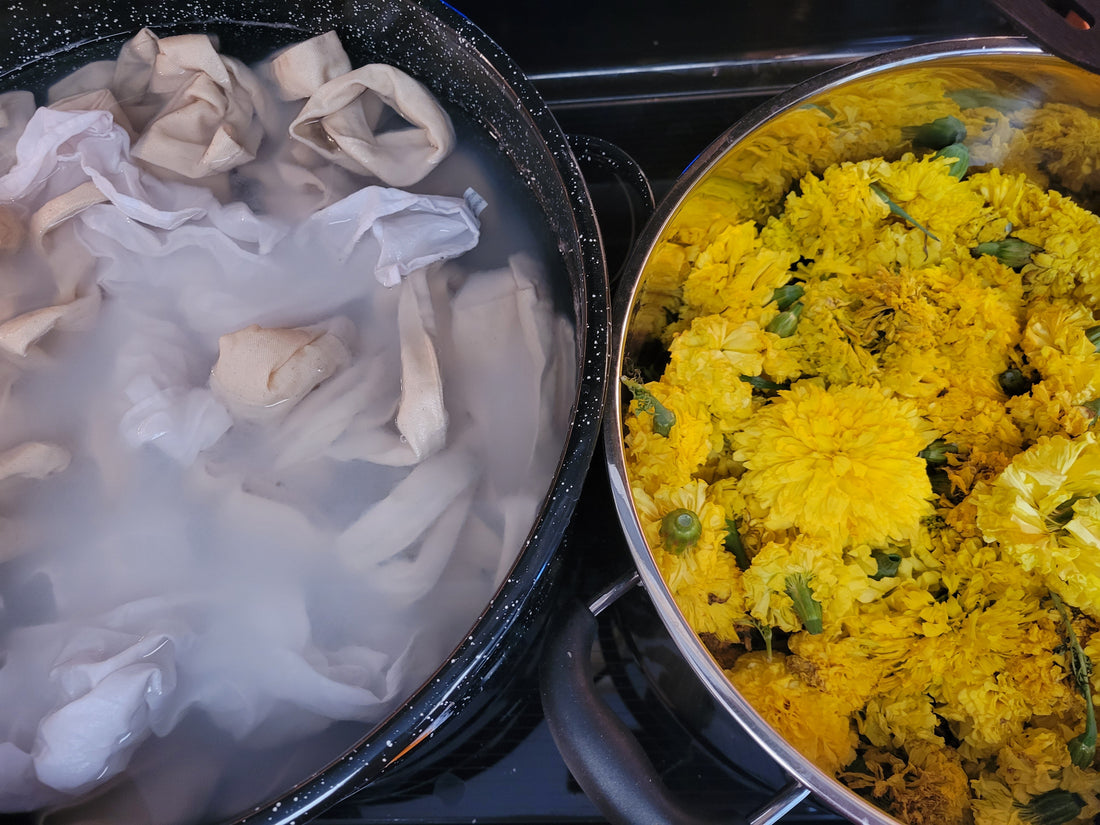
Marigolds for the Dye Garden: Bold Blooms, Brilliant Color
Share
Marigolds are a powerhouse in the dye garden—bold, easygoing, and brimming with color. These sunny blooms are more than just cheerful companions in vegetable beds or festive favorites in fall arrangements—they’re also an abundant and vibrant source of natural dye. Hardy, pest-resistant, and low-maintenance, marigolds thrive in the same challenging conditions that many dye plants prefer, making them a perfect choice for high desert climates like ours in Salt Lake.
I love growing marigolds for so many reasons: they’re bright, reliable bloomers; they attract pollinators and beneficial insects; and they’re wonderfully productive over a long season. But in the dye pot, they really shine. With even a small patch, you can get generous color yields that range from golden yellows to deep, earthy oranges—depending on the variety and dye method.
When and where should I plant my marigolds?
Marigolds are sun lovers through and through. Native to the Americas, they thrive in full sun, tolerate heat like champions, and don’t mind dry soil once they’re established. They’re a great fit for high-altitude gardens where the summers are intense and the soil isn’t always perfect.
If you’re growing from seed, start them indoors 4–6 weeks before your last frost date or sow directly outdoors once the danger of frost has passed and the soil has warmed. I usually plant marigold starts into the garden around mid-May. Choose a spot with full sun and well-drained soil—marigolds don’t like to sit in soggy ground.
Once they’re established, marigolds need very little care. Water sparingly and harvest flowers when they’re fully open. You can use the flowers fresh or dry them for use later in the season. I keep a supply of dried marigold heads in my dye studio for use all year long.
What varieties should I choose and what colors will they give me?
Marigolds come in a variety of species and cultivars, and nearly all of them are useful for dyeing. The two most commonly used in natural dyeing are Tagetes erecta and Tagetes patula.
-
Tagetes erecta (African or Aztec Marigold): These are the tall, large-headed marigolds with bright orange and yellow blooms. They’re pigment-rich and provide deep golden yellows and ochre tones in the dye pot. Their large petals also make them excellent for eco printing and tatakizome, leaving behind detailed, well-defined imprints.
-
Tagetes patula (French Marigold): These are more compact plants with smaller, often bi-colored blooms in shades of orange, red, and gold. They’re excellent for eco printing and produce a slightly more subtle but still lovely yellow-orange dye in immersion baths.
Marigolds: vibrant and easy in the garden and the dye pot
Marigolds are one of those perfect crossovers between beauty and function. They’re bold and festive in the garden, beloved by pollinators, and incredibly giving when it comes to natural dyeing. Whether you're simmering a pot of golden petals for a wool skein or pressing them into fabric for a sunny botanical print, marigolds offer a deeply satisfying and sustainable way to work with natural color.
If you’re looking to start or expand a dye garden, don’t overlook the humble marigold. It might surprise you with just how much it has to offer.
- Jennifer Samuelson
